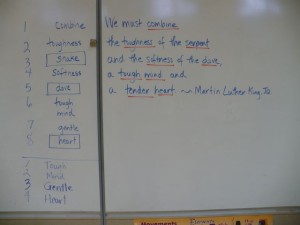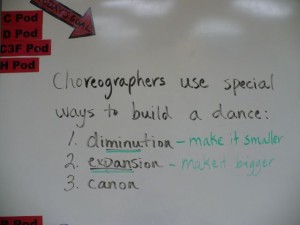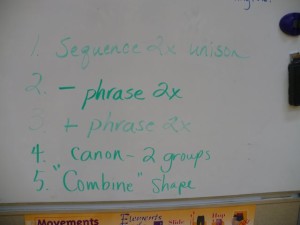Context: I taught this series of lessons this week in response to a late request for some dances for the school’s Martin Luther King, Jr. Day assembly (scheduled for & completed this past Thursday). My initial response was “no can do!” because I’d already planned my classes — focused on introducing the choreographic devices of diminution, expansion, and canon by manipulating phrases built on the concept of directions. But over the weekend, with a little time to mull, I decided I could maintain my emphasis on choreographic devices while manipulating phrases built on quotes from Dr. Martin Luther King, Jr.
So I started with my new groups on Monday, we worked through four 30-minutes classes, and they performed Thursday afternoon. There were only two classes that met 4 times before the assembly, so those were the classes that performed. My only regret was that the process had to be fairly prescribed — with more time, the kids could have had much more input in the choreographic process!
Grades: 3rd & 5th grade
Teaching points
Choreographers can build a dance from the ideas and images of words. Choreographers use diminution and expansion as strategies for building dances. Choreographers use canon as a strategy for building dances.
Dancers rehearse in order to do their best in performance.
Targets:
- Build a movement phrase based on a quote by Dr. Martin Luther King, Jr.
- Manipulate the phrase using diminution & expansion.
- Learn & practice the use of canon.
- Rehearse & perform a short dance including the original & manipulated phrases.
Lesson 1 : Choreographers can build a dance from the ideas and images of words.
- Identify the teaching point.
- Warm up using a yoga sequence that progresses through named yoga shapes. This is a warm-up my students already know, so it was an easy way to introduce the idea of building a dance based on words. The yoga sequence goes like this: mountain, tree, bird, woodchopper, big X & spiral (this is a transition, not an identifiable yoga shape), boat, V-sit, slide, whale, snake, cat, child, swallow, downward dog, mountain, moon, bow & arrow & eagle. The shapes come from a few books I have on yoga-for-kids — this one & several others that seem to be out-of-print — but there are various books with named shapes.
- Go over the quote from Dr. Martin Luther King, Jr. I used different quotes for the 3rd & 5th graders:
- We must combine the toughness of serpents and the softness of the dove, a tough mind and a tender heart. [3rd grade]
- We have learned to fly in air like birds and swim in the sea like fish, but we have not learned the simple art of living together like brothers. [5th grade]
- We must combine the toughness of serpents and the softness of the dove, a tough mind and a tender heart. [3rd grade]

3rd graders' quote

5th graders' quote
- Highlight the main words & learn movements for them. I used movements based on American Sign Language, cause it was early Monday morning, and my creative juices had not begun to flow. I checked on a website for some basic signs, using synonyms for signs that I couldn’t replicate from the website or signs that didn’t seem to fit the dance phrase.
- Practice the sequence together. [I asked the 3rd graders to word with a partner to make up their own movements for the words serpent, dove & heart, so most of the gestures were in unison, while those three varied among the duets.]
- Have students break into smaller groups & practice the sequence together.
- Homework: Learn the sequence, so we can play with it tomorrow!
Lesson 2: Choreographers use diminution and expansion as strategies for building dances.

Beginning to manipulate the sequence
- Identify today’s teaching point.
- Explore a key dance element related to the movement sequence. For the 3rd graders & their quote about “toughness” & “softness,” I lead students through an exploration of powerful & delicate effort actions — punch, float, press, glide — both with & without their voices (shouting “powerful” & whispering “delicate”). The 5th graders worked on the details of the basic phrase, so when they performed in unison, it would really be unison.
- Practice the sequence with music.
- Explain diminution & diminish the long sequence to a short one, by highlighting 4 key words, e.g. tough, mind, tender, heart for the 3rd graders. Practice the shortened phrase.
- Explain expansion & expand the shortened phrase spatially, either making the gestures larger or abstracting them by turning or moving them through space. Practice the expanded [short] phrase.
- Create a sequence, combining all the versions: twice through the full sequence, twice through the shorter phrase, twice through the expanded short phrase. [The 5th grade sequence was a little different — 2 full sequences, then the expanded short phrase 4 times.] Practice.
- Homework: Practice the diminished, expanded phrase.
Lesson 3: Choreographers use canon as a strategy for building dances.
- Practice the dance thusfar with music & narration.
- Introduce the use of canon. I show students two video exemplars… I use the short broom dance at the beginning of Stomp Out Loud, in which the dancers have unison moves, everyone’s different rhythms, and some moves they do in canon. I watch the kids to identify what the dancers are doing… unison, different, or canon (the canon section’s short but clear). I also show them Bourrée from Mark Morris’s Falling Down Stairs. Bourrée has a section of unison hand gestures, a floor section [for which I introduce the concept of the costume designer & ask the kids to notice the costumes, cause I know they’re going to think they’re a little weird], & a canon section of hand gestures.
- Practice the diminished, expanded phrase in canon, multiple ways (this group leads, that group leads, 8-count offset, 4-count offset) — for as much time as possible, so they get comfortable.
- Add a canon section to the end of the sequence so far & practice.
- Create an ending to the dance, if there’s time.

the 3rd graders' dance sequence

the final class before the assembly
Lesson 4: Dancers rehearse in order to do their best in performance.
- Day of performance! Set the stage for doing our best…
- Rehearse, fix the ending, practice the canon, run the whole dance several times, answer questions, troubleshoot problems… My 5th graders decided they wanted to end by improvise the ending by using any of the gestures from the dance sequence.
- Videotape the 3rd graders to catch one version without the boy who doesn’t have permission to be videotaped for the school’s website.
- Many congratulations and much encouragement…
The performance went fine, with a volunteer videotaping. I like the fact that the kids really knew & understood the quotes after working with them so thoroughly. When I get a chance, the videotape will be uploaded to the website, and I’ll link to it here. It could be awhile…
Meanwhile… if I haven’t made the process clear & you’re interested, just ask! And if you have a good idea for MLK Day, do share!
Tweets that mention Dancing for Dr. Martin Luther King, Jr. -- Topsy.com // Jan 17, 2010 at 10:17 am
[…] This post was mentioned on Twitter by danceadvantage, Rachel. Rachel said: Dancing for Dr. Martin Luther King, Jr.: Choreographers can build a dance from the ideas and images of words. Chor… http://bit.ly/8hrpnY […]
uberVU - social comments // Jan 17, 2010 at 6:13 pm
Social comments and analytics for this post…
This post was mentioned on Twitter by danceadvantage: Sharing– Dancing for Dr. Martin Luther King, Jr. http://bit.ly/6GIheb…
Clear and very well presented. I really love the detail you go into!
Thanks so much! I’m glad it’s clear! Writing up lesson plans is one of my least favorite things in the world, so I’m glad the progression is coming across.